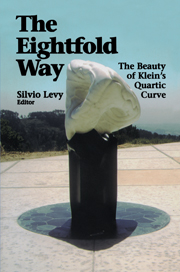Book contents
- Frontmatter
- Contents
- Preface: MSRI and the Klein Quartic
- The Eightfold Way: A Mathematical Sculpture by Helaman Ferguson
- The Geometry of Klein's Riemann Surface
- The Klein Quartic in Number Theory
- Hurwitz Groups and Surfaces
- From the History of a Simple Group
- Eightfold Way: The Sculpture
- Invariants of SL2(𝔽q) . Aut(𝔽q) Acting on ℂn for q = 2n ± 1
- Hirzebruch's Curves F1 , F2 , F4 , F14 , F28 for Q(V7)
- On the Order-Seven Transformation of Elliptic Functions
Preface: MSRI and the Klein Quartic
Published online by Cambridge University Press: 25 June 2025
- Frontmatter
- Contents
- Preface: MSRI and the Klein Quartic
- The Eightfold Way: A Mathematical Sculpture by Helaman Ferguson
- The Geometry of Klein's Riemann Surface
- The Klein Quartic in Number Theory
- Hurwitz Groups and Surfaces
- From the History of a Simple Group
- Eightfold Way: The Sculpture
- Invariants of SL2(𝔽q) . Aut(𝔽q) Acting on ℂn for q = 2n ± 1
- Hirzebruch's Curves F1 , F2 , F4 , F14 , F28 for Q(V7)
- On the Order-Seven Transformation of Elliptic Functions
Summary
On November 14, 1993, a marble and serpentine sculpturewas unveiled at the Mathematical Sciences ResearchInstitute in Berkeley, an event that marked one ofthe ways in which MSRI has been reaching out beyondits traditional role. The work had been commissionedfrom the famous mathematical sculptor HelamanFerguson, thanks to a generous donation fromMitsubishi Electric Research Laboratories (MERL)made for the purpose. This sculpture, and themathematical object that lies behind it, are thesubject of this book.
Felix Klein discovered in 1878 that a certain surface,whose equation (in complex projective coordinates)he gave very simply as x3y + y3Z + z3X = 0, has a number ofremarkable properties, including an incredible336-fold symmetry. He arrived at it as a quotientofthe upper complex half-plane by a modular groupthegroup of fractional linear transformations whosecoefficients are integers and that reduce to theidentity modulo 7. Since then, the same structurehas come up in different guises in many areas ofmathematics.
Ferguson's sculpture, TheEightfold Way, is a distillation of thebeauty and remarkable properties of the Kleinquartic. (See Plate 1 following page 142.) At thebase is a two-color stone mosaic, representing theuniformization of the surface: a regular hyperbolictesselation shown in the Poincare model. Rising outof the central tile, a seven-sided black column cupsthe artist's Carrara marble rendition of thesurface, which highlights its tetrahedralsymmetry.
Information
- Type
- Chapter
- Information
- The Eightfold WayThe Beauty of Klein's Quartic Curve, pp. ix - xPublisher: Cambridge University PressPrint publication year: 1999
